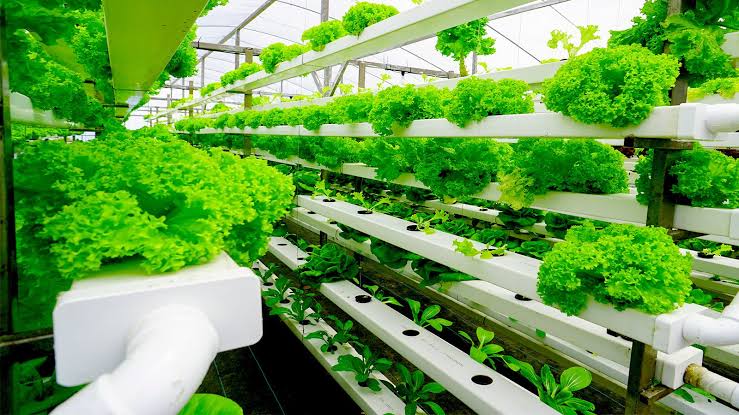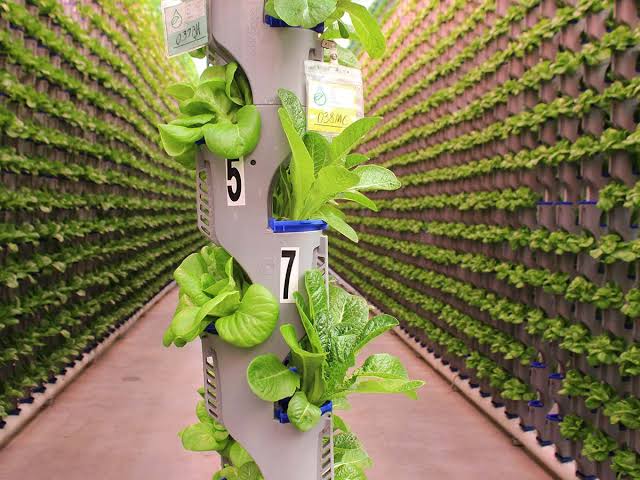Introduction
Vertical farming (ऊर्ध्व कृषि) is an innovative agricultural method that involves growing crops in vertically stacked layers, often integrated into urban environments. This method is especially relevant in India, where land availability for traditional farming is limited, and the demand for food is continually rising due to population growth. Vertical farming offers a sustainable solution, enabling the cultivation of crops in controlled environments (नियंत्रित वातावरण), thereby reducing the need for extensive agricultural land and minimizing water usage.

What is Vertical Farming?
Vertical farming (ऊर्ध्व कृषि) involves growing plants in stacked layers, often in controlled environments like greenhouses or indoor spaces. The technique uses various technologies such as hydroponics (हाइड्रोपोनिक्स), aeroponics (एरोपोनिक्स), and aquaponics (एक्वापोनिक्स) to provide nutrients to the plants without the need for soil. This method allows for year-round cultivation, irrespective of external weather conditions.
Types of Vertical Farming
- Hydroponics (हाइड्रोपोनिक्स):
- Definition: A soilless farming technique where plants grow in nutrient-rich water.
- Advantages: Water-efficient (जल कुशल), faster plant growth, and reduced need for pesticides.
- Disadvantages: High initial setup cost, technical expertise required.
- Aeroponics (एरोपोनिक्स):
- Definition: Plants are suspended in the air and their roots are misted with nutrient solutions.
- Advantages: Efficient nutrient absorption, space-saving, and water-efficient.
- Disadvantages: High cost, requires constant monitoring.
- Aquaponics (एक्वापोनिक्स):
- Definition: A symbiotic system that combines aquaculture (raising fish) with hydroponics.
- Advantages: Sustainable (सतत), organic produce, dual-income from fish and plants.
- Disadvantages: Complex system, requires careful balance between fish and plant needs.
Benefits of Vertical Farming in India
- Space Utilization (अंतरिक्ष का उपयोग):
- Urban Farming (शहरी कृषि): Vertical farming enables the use of underutilized urban spaces like rooftops, basements, and abandoned buildings for agriculture, making it ideal for densely populated cities.
- Water Conservation (जल संरक्षण):
- Efficient Water Use (जल कुशल उपयोग): Vertical farming uses up to 90% less water than traditional farming methods, crucial for water-scarce regions in India.
- Year-Round Production (साल भर उत्पादन):
- Controlled Environment (नियंत्रित वातावरण): Crops can be grown throughout the year, regardless of seasonal changes, ensuring a continuous food supply.
- Reduction in Transportation Costs (परिवहन लागत में कमी):
- Local Production (स्थानीय उत्पादन): Crops are grown closer to the point of consumption, reducing the carbon footprint (कार्बन पदचिह्न) associated with transportation.
- Pesticide-Free Produce (कीटनाशक मुक्त उत्पाद):
- Controlled Environment: The controlled environment reduces the need for pesticides, leading to healthier, organic produce.
Challenges of Vertical Farming in India

- High Initial Investment (उच्च प्रारंभिक निवेश):
- Cost (लागत): Setting up vertical farms requires significant capital investment, which can be a barrier for small farmers.
- Technical Expertise (तकनीकी विशेषज्ञता):
- Skill Requirement (कौशल आवश्यकता): Managing a vertical farm requires knowledge of advanced agricultural technologies, which may not be readily available in all regions.
- Energy Consumption (ऊर्जा खपत):
- Lighting and Climate Control (प्रकाश और जलवायु नियंत्रण): The need for artificial lighting and climate control systems increases energy consumption, leading to higher operational costs.
- Market Acceptance (बाज़ार स्वीकृति):
- Consumer Awareness (उपभोक्ता जागरूकता): There is a need to educate consumers about the benefits of vertically farmed produce, as traditional agricultural products are often preferred.
Vertical Farming in Indian Cities
- Delhi:
- Projects (परियोजनाएँ): Several startups in Delhi are experimenting with vertical farming, focusing on leafy greens and herbs for the local market.
- Benefits (लाभ): Helps address the food supply challenges in the densely populated capital.
- Mumbai:
- Urban Farming: Vertical farming is being explored as a way to utilize the limited space available in the city.
- Impact (प्रभाव): Reduces the dependency on food transported from rural areas.
- Bengaluru:
- Innovation Hub (नवाचार केंद्र): Known for its tech-savvy population, Bengaluru is seeing a rise in tech-driven vertical farming projects.
- Focus (ध्यान): Primarily on high-value crops like microgreens and exotic vegetables.
Government Initiatives and Support
- Subsidies and Grants (अनुदान और सब्सिडी):
- Support (सहायता): The Indian government offers subsidies and grants for vertical farming projects under various schemes to promote sustainable agriculture.
- Impact (प्रभाव): Encourages adoption among farmers and entrepreneurs.
- Research and Development (अनुसंधान और विकास):
- Institutes (संस्थान): Agricultural universities and research institutes are conducting studies on the feasibility and benefits of vertical farming in India.
- Outcome (परिणाम): Development of cost-effective vertical farming models suitable for the Indian context.
- Public-Private Partnerships (सार्वजनिक-निजी भागीदारी):
- Collaboration (सहयोग): Partnerships between government agencies and private companies are fostering the growth of vertical farming through shared resources and expertise.
Nutritional Profile Table of Vertical Farming Produce
| Nutrient (पोषक तत्व) | Amount per 100g (प्रति 100 ग्राम मात्रा) | Benefits (लाभ) |
|---|---|---|
| Vitamin A | 800 IU | Supports eye health (आंखों की सेहत को समर्थन करता है) |
| Vitamin C | 40 mg | Boosts immunity (प्रतिरक्षा को बढ़ावा देता है) |
| Iron | 2.7 mg | Prevents anemia (एनीमिया को रोकता है) |
| Calcium | 50 mg | Strengthens bones (हड्डियों को मजबूत बनाता है) |
| Protein | 2.5 g | Muscle repair (मांसपेशियों की मरम्मत) |
Future of Vertical Farming in India
- Technological Advancements (प्रौद्योगिकी में प्रगति):
- Automation (स्वचालन): The use of AI and IoT in vertical farming is expected to reduce labor costs and increase efficiency.
- Innovation (नवाचार): Continuous R&D will lead to the development of more affordable and scalable vertical farming solutions.
- Sustainability (सततता):
- Eco-Friendly Practices (पर्यावरण अनुकूल प्रथाएँ): As awareness of environmental issues grows, vertical farming will play a crucial role in sustainable urban agriculture.
- Reduced Carbon Footprint (कार्बन पदचिह्न में कमी): Localized production and reduced transportation needs will contribute to a lower carbon footprint.
- Food Security (खाद्य सुरक्षा):
- Urban Agriculture (शहरी कृषि): Vertical farming will be integral to ensuring food security in India’s growing urban centers by providing fresh produce locally.
- Rural Adoption (ग्रामीण अपनाने): With government support, vertical farming could also be adopted in rural areas, enhancing productivity and income for farmers.
FAQ Section
Q1: What is vertical farming? (ऊर्ध्व कृषि क्या है?)
A: Vertical farming is the practice of growing crops in vertically stacked layers, often using soilless farming techniques like hydroponics, aeroponics, or aquaponics.
Q2: Why is vertical farming important for India? (भारत के लिए ऊर्ध्व कृषि क्यों महत्वपूर्ण है?)
A: Vertical farming is important for India because it helps address challenges like limited agricultural land, water scarcity, and urbanization, while ensuring a consistent food supply.
Q3: What crops can be grown using vertical farming in India? (भारत में ऊर्ध्व कृषि का उपयोग करके कौन सी फसलें उगाई जा सकती हैं?)
A: Common crops include leafy greens, herbs, microgreens, strawberries, and high-value vegetables.
Q4: What are the challenges of vertical farming in India? (भारत में ऊर्ध्व कृषि के क्या चुनौतियाँ हैं?)
A: Challenges include high initial investment, need for technical expertise, high energy consumption, and market acceptance.
Q5: How does vertical farming contribute to sustainability? (ऊर्ध्व कृषि सततता में कैसे योगदान देती है?)
A: Vertical farming contributes to sustainability by conserving water, reducing land use, and lowering carbon emissions associated with transportation.
Conclusion
Vertical farming in India holds immense potential to revolutionize the agricultural sector by addressing the challenges of land scarcity, water
